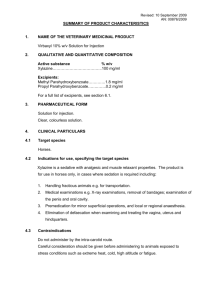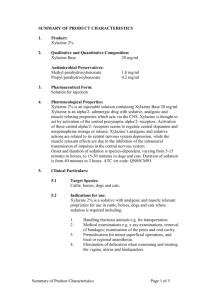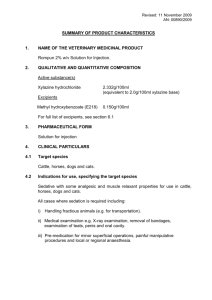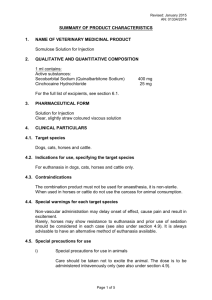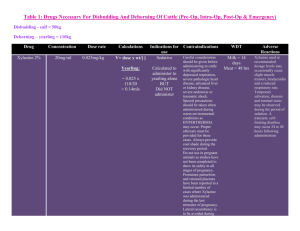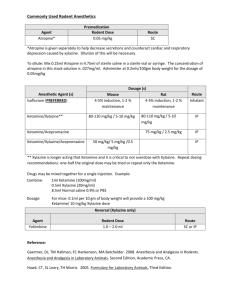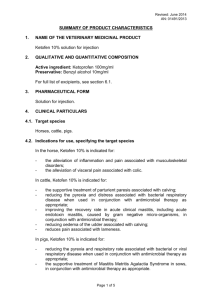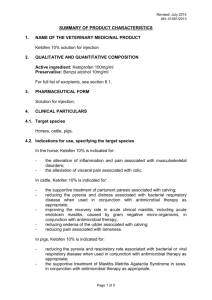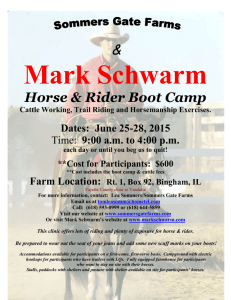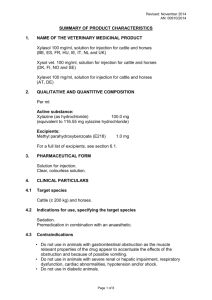summary of the product characteristics
advertisement
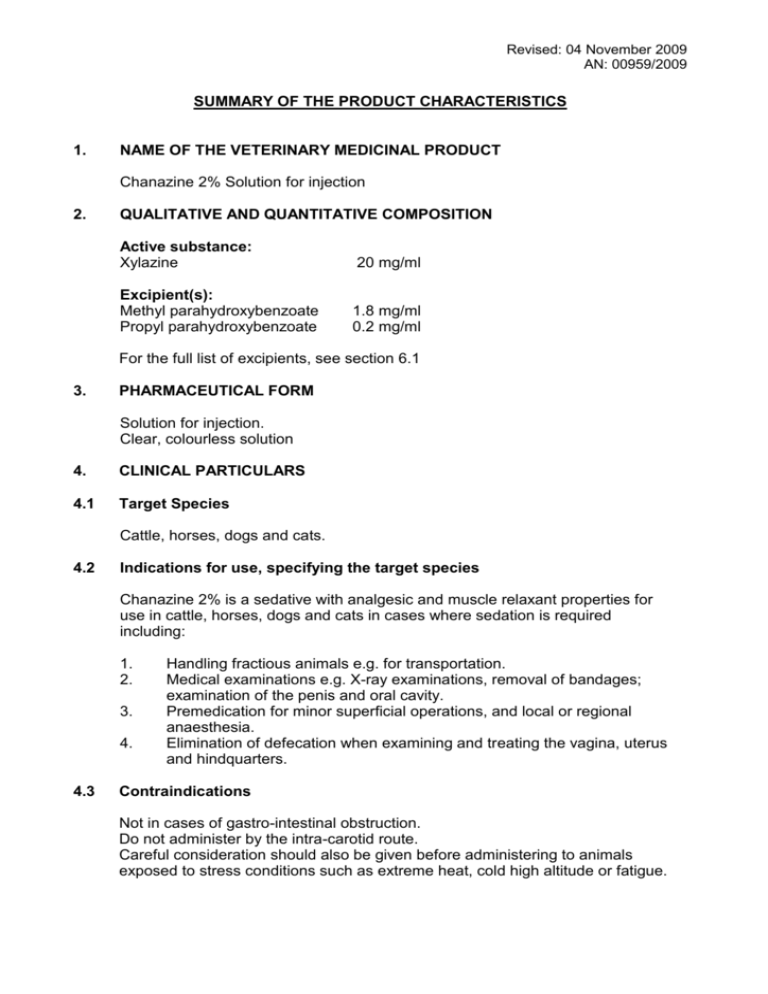
Revised: 04 November 2009 AN: 00959/2009 SUMMARY OF THE PRODUCT CHARACTERISTICS 1. NAME OF THE VETERINARY MEDICINAL PRODUCT Chanazine 2% Solution for injection 2. QUALITATIVE AND QUANTITATIVE COMPOSITION Active substance: Xylazine 20 mg/ml Excipient(s): Methyl parahydroxybenzoate Propyl parahydroxybenzoate 1.8 mg/ml 0.2 mg/ml For the full list of excipients, see section 6.1 3. PHARMACEUTICAL FORM Solution for injection. Clear, colourless solution 4. CLINICAL PARTICULARS 4.1 Target Species Cattle, horses, dogs and cats. 4.2 Indications for use, specifying the target species Chanazine 2% is a sedative with analgesic and muscle relaxant properties for use in cattle, horses, dogs and cats in cases where sedation is required including: 1. 2. 3. 4. 4.3 Handling fractious animals e.g. for transportation. Medical examinations e.g. X-ray examinations, removal of bandages; examination of the penis and oral cavity. Premedication for minor superficial operations, and local or regional anaesthesia. Elimination of defecation when examining and treating the vagina, uterus and hindquarters. Contraindications Not in cases of gastro-intestinal obstruction. Do not administer by the intra-carotid route. Careful consideration should also be given before administering to animals exposed to stress conditions such as extreme heat, cold high altitude or fatigue. Revised: 04 November 2009 AN: 00959/2009 4.4 Special warnings for each target species None Known 4.5 Special precautions for use i. Special precautions for use in animals Caution where pulmonary disease is suspected. ii. Special precautions to be taken by the person administering the veterinary medicinal product to animals Horses sedated with xylazine usually remain standing and may still kick with accuracy. Precaution should be taken to avoid accidental injection / self injection. 1. 2. 3. 4. 5. 6. 7. 4.6 In the case of accidental oral intake or self-injection, seek medical advice immediately and show the package leaflet to the doctor but DO NOT DRIVE as sedation and changes in blood pressure may occur. Avoid skin, eye or mucosal contact. Immediately after exposure, wash the exposed skin with large amounts of fresh water. Remove contaminated clothes that are in direct contact with the skin. In the case of accidental contactof the product with eyes, rinse with large amounts of fresh water. If symptoms occur, seek the advice of a doctor. If pregnant women handle the product, special caution should be observed not to self-inject as uterine contractions and decreased foetal blood pressure may occur after accidental systemic exposure. Advice to Doctors: Xylazine is an alpha2-adrenoreceptor agonist. Symptoms after absorption may involve clinical effects including dosedependent sedation, respiratory depression, brachycardia, hypotension, a dry mouth, and hyperglycaemia. Ventricular arrhythmias have also been reported. Respiratory and haemodynamic symptoms should be treated symptomatically. Adverse reactions (frequency and seriousness) Following the use of Chanazine 2% in cattle profuse salivation, bloat and polyuria may occur. Tympany should be avoided in recumbent cattle by maintaining the animal in sternal recumbency. Provision should also be made for facilitating dependent drainage from the mouth to avoid inhalation asphyxia. Side effects such as bradycardia, cardiac arrhythmia and polyuria may occur in the horse. Following intravenous administration to horses a transient rise followed by a fall in blood pressure usually occurs. Vomiting is commonly observed in dogs and cats following use of the product. Revised: 04 November 2009 AN: 00959/2009 4.7 Use during pregnancy, lactation and lay Chanazine 2% should not be administered during the later stages of pregnancy because of the risk of inducing premature parturition. As the safety of xylazine use during organogenesis has not been fully demonstrated by current methods it should be used with caution during the first month of pregnancy. 4.8 Interaction with other medications and other forms of interaction None known. 4.9 Amounts to be administered and administration route Cattle: Chanazine 2% is given by intramuscular injection. The dose rate is 0.05-0.3 mg/kg (0.25-1.5 ml /100 kg) bodyweight, according to the degree of sedation required. Very fractious animals may require the higher dose rates not exceeding 0.3 mg/kg (Dose rate 4). Dose 1 2 3 4 mg/kg 0.05 0.10 0.20 0.30 mg/50 kg 2.5 5.0 10 15 ml/50 kg 0.12 0.25 0.50 0.75 Horses: Chanazine 2% is given by slow intravenous injection. Dosage depends upon the degree of sedation required and the response of the animal and is 0.6-1 mg/kg (35 ml/100 kg) bodyweight. Nervous or excitable horses may require higher doses. Older horses and those having undergone severe physical exertion before treatment should receive the lowest dose rate. The horse does not usually become recumbent with Chanazine 2% and light to deep sedation with variable degree of analgesia is obtained. Effects are usually seen within 5 minutes and persist for approximately 20 minutes. Chanazine 2% may be employed in the horse as a premedication to barbiturate anaesthesia or in combination with regional or local anaesthesia. Dogs: Chanazine 2% is administered intramuscularly at dose rates of 1 - 3 mg/kg (0.05 0.15 ml/kg bodyweight). It may be used in combination with a local anaesthetic. Premedication with atropine may be desirable in some cases. Chanazine 2% is synergistic with the barbiturates and reduces the dosage of the latter by approximately one half. Cats: Chanazine 2% is administered intramuscularly at a dose rate of 3 mg/kg (0.15 ml/kg bodyweight). Premedication with atropine may occasionally be desirable. Revised: 04 November 2009 AN: 00959/2009 4.10 Overdose (symptoms, emergency procedures, antidotes), if necessary Profound cardiovascular effects or exacerbated side effects specified in 4.6 may result from overdosage. Cattle are 10 times more sensitive than horses. Do not repeat the dose in the event of unsatisfactory response. Repeat on the following day. 4.11. Withdrawal periods Animals must not be slaughtered for human consumption during treatment. Cattle may be slaughtered for human consumption only after 14 days from the last treatment. Not for use in animals from which milk is produced for human consumption. Not to be used in horses intended for human consumption. Treated horses may never be slaughtered for human consumption. The horse must have been declared as not intended for human consumption under national horse passport legislation. 5. PHARMACOLOGICAL PROPERTIES Sedative, analgesic and muscle relaxing properties ATCvet code: QN05CM92 5.1 Pharmacodynamic properties Chanazine 2% is an injectable solution containing Xylazine Base 20 mg/ml. Xylazine is an α2-adrenergic drug with sedative, analgesic and muscle relaxing properties which act via the CNS. Xylazine is thought to act by activation of the central presynaptic α2-receptors. Activation of these central α2- receptors seems to regulate central dopamine and norepinephrine storage or release. Xylazine’s analgesic and sedative actions are related to its central nervous system depression, while the muscle relaxant effects are due to the inhibition of the intraneural transmission of impulses in the central nervous system. 6. PHARMACEUTICAL PARTICULARS 6.1 List of excipients Methyl Parahydroxybenzoate Propyl Parahydroxybenzoate Hydrochloride Acid Conc. Sodium Citrate Dihydrate Citric Acid Monohydrate Sodium Chloride Water for Injection 6.2 Incompatibilities None known. Revised: 04 November 2009 AN: 00959/2009 6.3 Shelf-life Shelf life of the veterinary product as packaged for sale: 5 years. Shelf life after first opening the immediate packaging: 28 days. 6.4 Special Precautions for storage Do not store above 25°C. Following withdrawal of the first dose, use the product within 28 days. Discard unused material. 6.5 Nature and composition of immediate packaging Amber vials, Type I Ph. Eur glass, containing 25 ml. Elastomeric closures 20 mm. Aluminium seals with removable centres. 6.6. Special precautions for the disposal of unused veterinary medicinal product or waste materials derived from the use of such products Any unused veterinary medicinal product or waste materials derived from such veterinary medicinal products should be disposed of in accordance with local requirements. 7. MARKETING AUTHORISATION HOLDER Chanelle Animal Health Ltd, 7 Rodney St. Liverpool L1 9HZ UK. 8. MARKETING AUTHORISATION NUMBER(S) Vm 11990/4005 9. DATE OF FIRST AUTHORISATION/RENEWAL OF THE AUTHORISATION Date of First Authorisation: Date of Renewal of the Authorisation: 10. DATE OF REVISION OF THE TEXT November 2009 03/09/1991 03/09/2006
